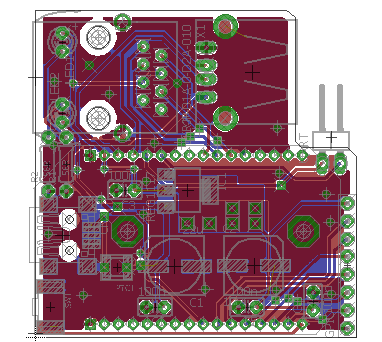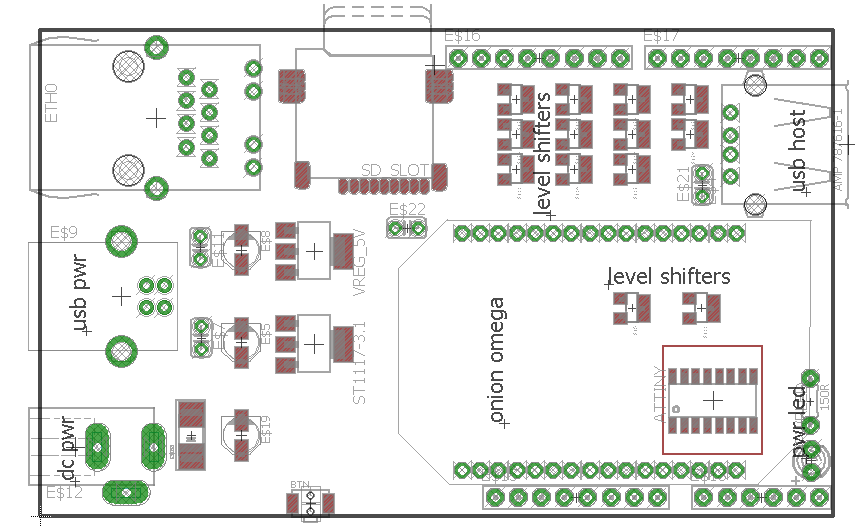yeah, i know the vocore, but never though of implementing the same usb port, silly me 
though right now it isn't on my priority list, i want to make sure everything is correct on the pcb design
feel free to change it though 
yeah, i know the vocore, but never though of implementing the same usb port, silly me 
though right now it isn't on my priority list, i want to make sure everything is correct on the pcb design
feel free to change it though 
@Boken-Lin I don't recommend tags, as people can input the most irrelevant tags for example.
edit:
what would be better is to have catogories as the main 'tag' (example: hardware, support, projects)
and still have the tagging system as it is now, but more intended for sub-tags, like in the "hardware" catogory a topic called "how to use GPIO?"
where the subtags can be like: "GPIO, SPI"
i hope this clarifies what i mean 
That's an option, though I don't want the picorouter to be too high in size.
Plus, I designed the USB port a bit inward so it could fit a micro USB stick (for storage expansion) without growing too much in dimensions.
You are free to modify the design though 
edit: changed some stuff and new pcb version is up, see the top post
what are the hardware spi pins on the headers (if they are on there at all)?
@Paul-Wright i'd suggest a catogory for hardware as well
new version R02
includes:
added ground nets
fixed some spacing issues
see top post
also, looking at this line on their webpage:
"Build fast with Node.js/io.js, then optimize the hardware and build thousands."
this seems like they have some right on their design preventing you from using it in commercial products.
it seems that the tessel is open source, but the pcb design is far too complicated for news ones, so i'd go for a onion omega, with the addition of a custom base board 
and i like the appstore on the omega as well 
i don't know, but i prefer the omega, mainly due to open source software and the pcb size 
the download link is in my post above, feel free to use and modify to your likings.
and so, i got a christmas present for you all, namely: the zipped project!
contains: .brd and .sch file
yes, i made a schematic as well 
current revision: R01
use at own risk though!
thanks, this is exactly what i was looking for, not i can correct my design as post it 
note to my previous post:
this reminds me of something i encountered a few years ago, having the same problems.
it was solved by running this command: a2enmod php5
this could be the solution for you as well.
you basically need to install LAMP server, a tutorial can be found here: https://wiki.onion.io/Tutorials/How-To-Install-LAMP-Stack-on-the-Omega
then the RAM problem still exists i guess
also, maybe offtopic:
well, to be honest, i miss the good old days when windows needed 4mb of RAM, and 50MB hdd space (windows 95 era)
nowadays i am against inefficient resource usage (like max os x and windows 8.1/10 have)
i don't say i hate it though, but i don't support it
1: that filesystem expanding is for openwrt itself (i think)
2: the ram the omega has is way below the requirements of windows 10 iot.
that's why i'm so sure it won't be happening.
Intro
i am developing a picorouter for the onion omega
The target is to have enough functionatlity to act similar as a wr703n, but in a smaller form factor while still being easy to hack.
Image of board R03:

Specs
onion omega pinheaders
46x47mm (was: 46*49mm on R2-01 and before) (surface: roughly 21 square cm)
ethernet port (with built in transformers) x1
usb port x1 (moved inwards for a micro usb stick without sticking it out too much (prevents damage  ))
))
3.3v ldo (st1117 3.3v fixed regulator)
usb power in
power leds on the ethernet jack
GPIO: 6 on a header (with 3.3V and GND lines)
rx/tx available as well
Todo
case design(?)
pcb checking and such
Changelog:
current version: R03
R03:
reset-able 500mA fuse on USB +VIN line
increased input capacitor from 10u to 22u
changed LED 13 to GPIO13 instead of +3V
both led resistors to 56ohm instead of 220ohm (increases led brightness)
small routing imporvements
R02-2:
fixed the ethernet shielding and added required voltage lines for the transformers in the ethernet jack
slightly smaller in height
R02-1 has no additional features, except that the overlapping rx-tx signals are fixed.
Files/downloads
download links below:
if you want to order board R02-2 right away (about $17 for 3 pcb's) :
https://oshpark.com/shared_projects/FGrlPzE9
Assembling
0: check if there are manufacturing errors with a mulitmeter!
1: solder all components on their place, beginning with the smt ones (ldo, usb mini, caps)
2: solder connectors and (pin)headers
3: check if there are soldering errors with a mulitmeter!
4: plug in the onion omega
5: optional: plug in microusb stick (or other desired usb device) and/or ethernet cable
6: make sure there's no shortings again (with multimeter)!
7: power up
8: if the green led on the ethernet jack lights up you've done it right.
9: ??? ??? ???
10: profit 
Want to help?
You can help realizing this project on multile ways, by:
Credits
hardware design: ramon schepers
the omega: onion.io
Licence
you may sell it as your own, use it as your own, but the only thing you need to know is: all responsibility is up to YOU if you do something with it.
sadly i am not a pro at pcb design, and am terrible at schematic design and usage (i mostly do my projects out of my head to be honest)
but i can give it a try and
design a board
order a test batch of 3 ast oshpark
test it
if it fails, i'll need to redo the three steps above till i get it right
if i get enough support from the community, i'd go for it.
though, i have one request: the gerber files of my design need to be open source.  (i just like open source)
(i just like open source)
and notes about the gui thing: i'm not going to drive a 640480 resolution (which is easy for a mcu at 168mhz), i'm planning on 320240 pixels (as the driver ic ili934x supports)
also, i think the raspberry pi isn't what all people want for diy assembling,
so basically i want to use the omega as a system on module, on which you can develop your own hardware and drivers for it using arduino headers 
regarding the embedded gpu: i'd suggest looking at the FT8xx series spi gpu it has high resolution, touch drivers, audio management (though poor quality) all in one qfn package.
if you're going for a ft8xx gpu, i'd suggest a ft800 for a small size (240320px to 480272px (psp screen resolution))
ramon.
seems i can't edit the post, but here's why i want such a layout:
to use a ili9340 or ili9341 screen with touch sensing and make a diy mini pc with gmenu2x as GUI 
not that it'll be very efficient, but i want to have a prove of concept in my hands.
i saw those articles, which made me wonder about the 16mb onboard flash 
also, just thinking of something else with the omega, namely a all in one adapter board, with:
arduino-style header adapter with the needed level shifters, power, ethernet, microsd and analog potmeters using an attiny for analog to serial reads. 
please tell me your opinion on this.
